Five Practical Scenarios When You Need a Cabinet Fan
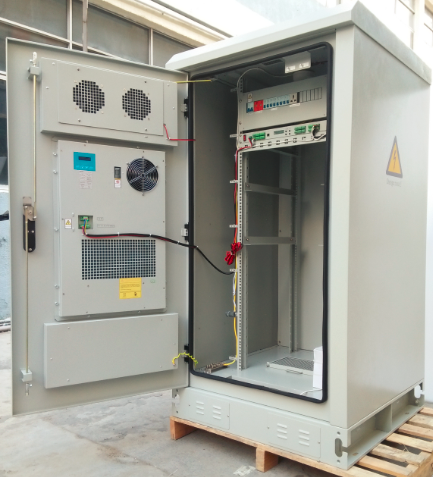
Ever wondered why your equipment gets so hot inside cabinets? You might need a Cabinet Fan for extra cooling if you notice these situations:
High heat equipment packed together
Cabinets with no natural airflow
Sensitive electronics at risk
Dusty environments
Hot rooms or locations
Overheating can cost you thousands in lost profit, labor, and restart expenses every time it strikes.
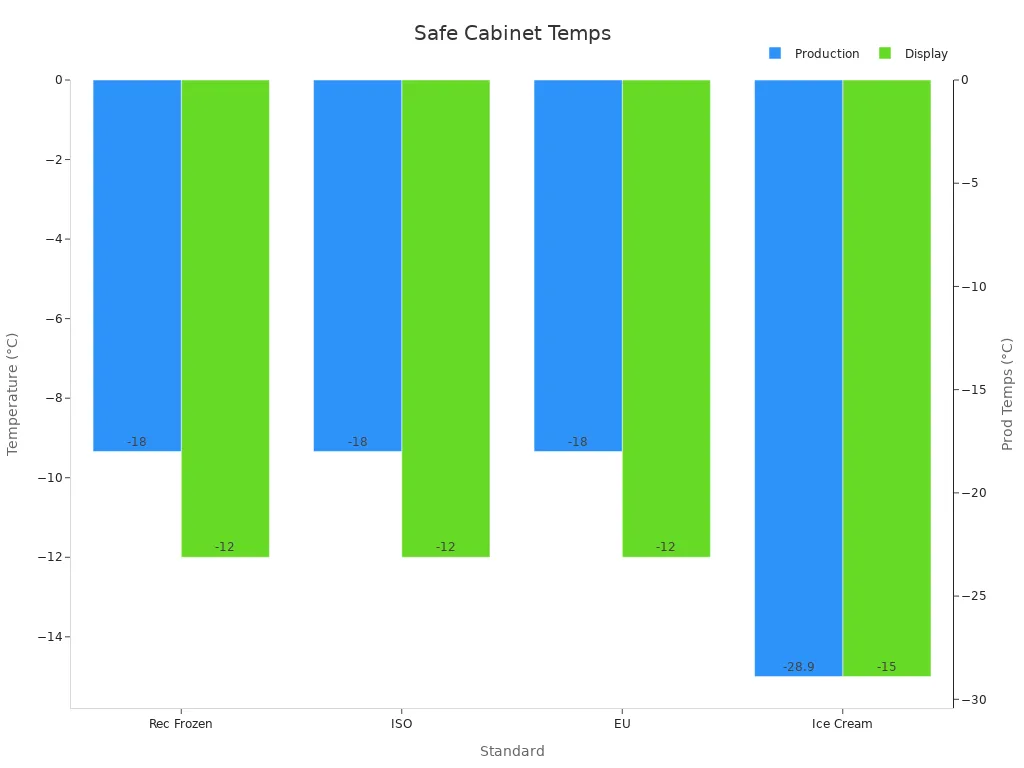
Keeping the right temperature and airflow with a Cabinet Fan protects your gear and your wallet.
Key Takeaways
High heat equipment inside cabinets can cause serious overheating, which lowers performance and shortens device life. Using a cabinet fan helps keep temperatures steady and protects your gear.
Enclosed cabinets often trap warm air due to poor airflow. Adding a cabinet fan improves air movement, prevents hot spots, and extends the life of your electronics.
Sensitive electronics need stable temperature and humidity. Cabinet fans reduce heat stress and moisture risks, lowering failure rates and maintenance costs.
Dust can enter cabinets easily and cause damage by blocking airflow and harming components. A cabinet fan with a filter keeps dust out and keeps your equipment cleaner.
Hot locations make natural cooling ineffective. Proper fan placement and airflow control help maintain safe temperatures and save energy in warm environments.
1. High Heat Equipment
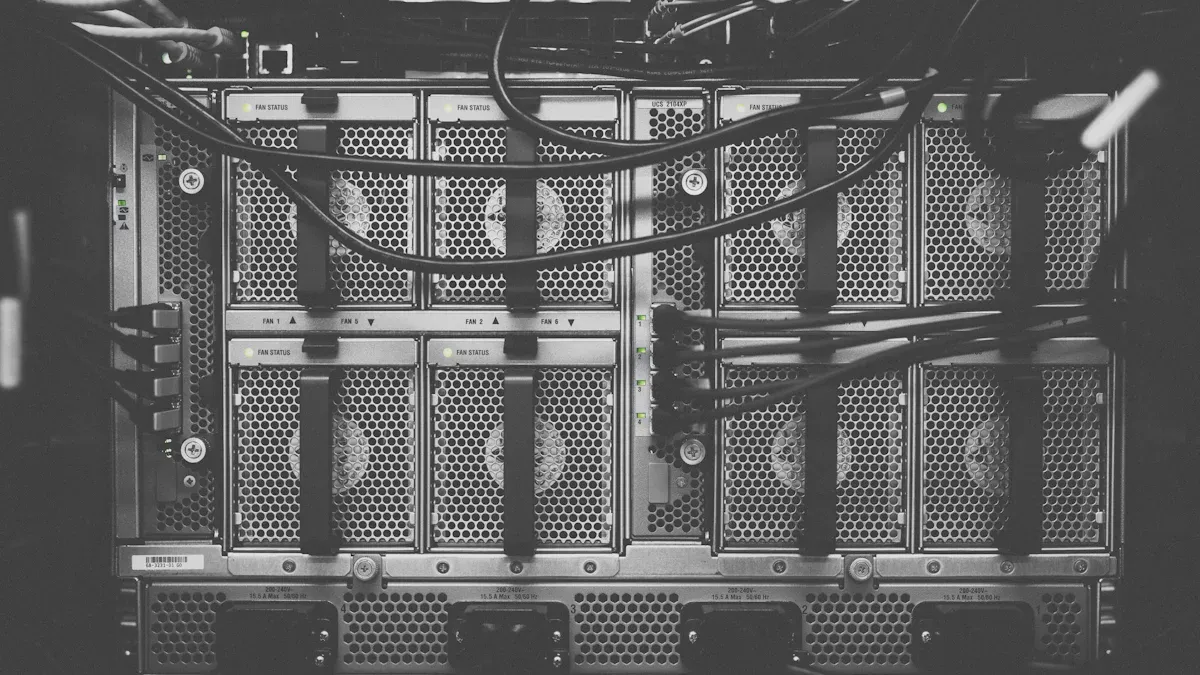
Heat Sources
You probably know that some equipment inside cabinets gets hot fast. Servers, amplifiers, and power supplies are the main culprits. They work hard and use a lot of power, which means they pump out a lot of heat. For example:
AI servers with high-performance GPUs can use up to 10 kW of power each.
Some server racks in data centers handle over 60 kW, and in extreme cases, even 300 kW per rack.
Multiple power distribution units (PDUs) and redundant power supplies keep everything running, but they also add to the heat load.
Component/Metric | Statistic/Description |
|---|---|
Single NVIDIA DGX AI Server | Consumes about 10 kW of power, creating significant heat per server. |
AI Infrastructure Power per Rack | Often exceeds 60 kW, sometimes reaching 100–300 kW per rack. |
Power Distribution Units (PDUs) | 3–6 per rack, needed for high power loads and reliability. |
Cooling Requirements | Air cooling alone is not enough; advanced cooling methods are often required. |
Overheating Risks
When you pack high heat equipment into a cabinet, you risk more than just a warm touch. Overheating can slow down your devices by 10–15% for every 10°C rise in temperature. It can also double the failure rate of electronic parts, shorten their lifespan, and even cause safety hazards like fires. You might notice strange noises, signal problems, or even total shutdowns if things get too hot. In some cases, cabinet inlet temperatures can shoot past 27°C and reach up to 36.7°C, which puts your equipment at serious risk of downtime.
Tip: Overheating doesn’t just hurt performance—it can cost you big in repairs and lost productivity.
Fan Solution
A Cabinet Fan steps in as your first line of defense. It pulls hot air out and brings cooler air in, keeping temperatures steady. Studies show that with proper airflow management, including cabinet fans, you can boost air supply efficiency from about 65% to over 90%. This means less wasted cooling and fewer hotspots. Fans help keep the temperature difference inside your cabinet within 2°C, so your equipment stays safe and reliable. In real-world tests, cabinets with fans maintained safe temperatures even during heat waves, and energy savings reached up to 72% compared to traditional cooling.
If you have high heat equipment, adding a Cabinet Fan is a smart move to protect your investment and keep everything running smoothly.
2. Enclosed Cabinets
Limited Airflow
Have you ever opened a cabinet and felt a wave of warm, stale air? That’s a sign of limited airflow. Many cabinets, especially those built into walls or furniture, have little or no natural ventilation. You might see this with AV cabinets, network enclosures, or even display cases. When air can’t move freely, heat gets trapped inside. Scientific studies use tools like Particle Image Velocimetry (PIV) and Computational Fluid Dynamics (CFD) to measure airflow in closed cabinets. The results show that air velocities inside these spaces often stay between 0 and 0.7 meters per second—barely enough to keep things cool.
Aspect | Description | Quantitative Findings |
|---|---|---|
Measurement Techniques | PIV and CFD analyze airflow in closed cabinets | |
Airflow Phenomena | Air recirculation and infiltration through gaps | Stable air curtain in closed cabinets |
Energy & Thermal Effects | Door retrofitting saves energy and controls temperature | Energy savings: 23–73%; temp drop: up to 6°C |
Stagnant Air Problems
When airflow stalls, your cabinet turns into a mini sauna. Warm air builds up, and the temperature inside rises quickly. Blocked vents or cabinets pushed against walls make things worse. Devices inside start to overheat, which can slow them down, shorten their lifespan, or even cause them to fail. Studies show that cabinets with poor ventilation can have temperature differences of up to 4.9°C from one spot to another. That means some devices get much hotter than others, leading to uneven wear and more frequent breakdowns. In real-world tests, telecom cabinets without fans reached internal temperatures as high as 44°C—way above safe limits.
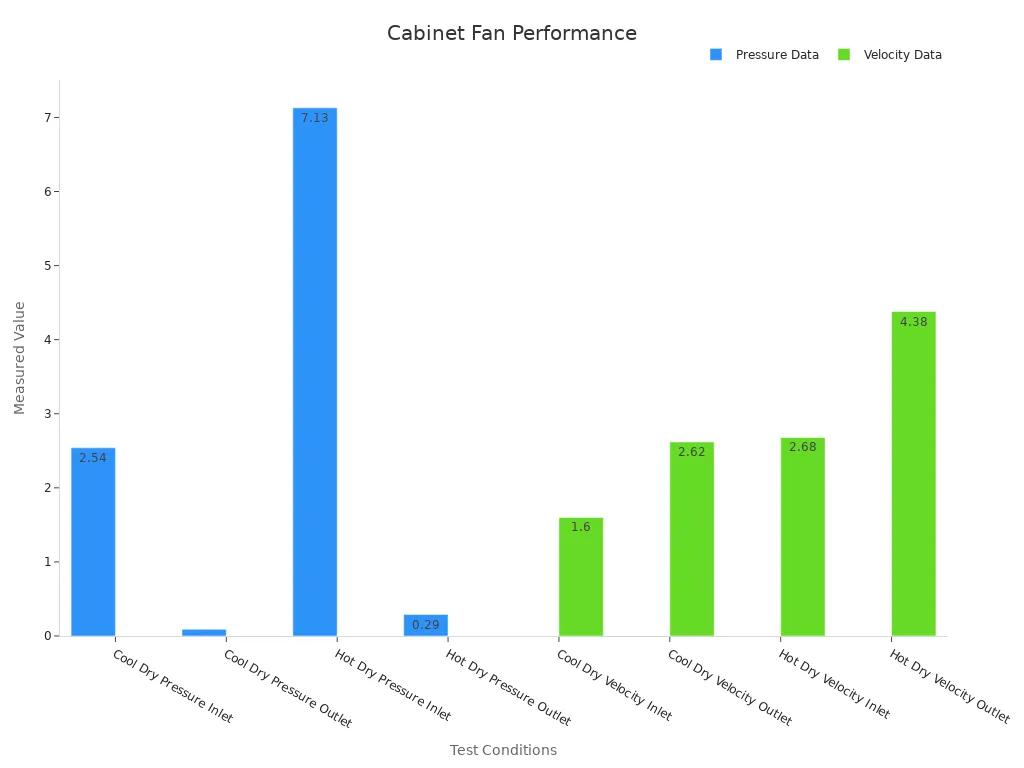
Cabinet Fan Benefits
You can solve these problems by adding a Cabinet Fan. Fans boost airflow, push out hot air, and pull in cooler air from outside. This keeps the temperature steady and prevents hot spots. Here’s what makes fans so effective:
Airflow volume (measured in CFM or CMH) shows how much air moves through your cabinet, helping to remove heat.
Static pressure lets the fan overcome obstacles like filters or tight spaces.
Axial fans work well for general cooling, while centrifugal fans handle dense setups.
Fans keep temperatures even, protect sensitive electronics, and extend equipment life.
With a Cabinet Fan, you get a simple, low-cost way to keep your gear safe and running smoothly—even in the tightest, most enclosed spaces.
3. Sensitive Electronics
Vulnerable Devices
You probably have some electronics that need extra care. Devices like SSDs, CPUs, GPUs, and memory modules are especially sensitive to heat and humidity. Even small temperature changes can cause big problems. Moisture-sensitive devices, such as certain chips and sensors, also need strict humidity control. If you store these electronics in a cabinet, you must pay close attention to their environment. Automated tracking systems now monitor exposure times because even short periods of high temperature or humidity can lead to damage.
Damage Risks
Sensitive electronics face many risks when the temperature inside a cabinet goes up or down too quickly. For every 10°C increase, the lifespan of electronic parts gets cut in half. Moisture Sensitivity Level (MSL) ratings drop, which means your devices become more likely to suffer from microcracking, delamination, or packaging breakdown. About 65% of IT equipment failures happen because of poor cooling. Cooling-related failures even cause one in eight major outages each year, according to the Uptime Institute. Here are some common ways thermal stress can hurt your electronics:
Warpage, cracking, and delamination from thermal expansion
Corrosion and chemical breakdown at higher temperatures
Electrical failures like dielectric breakdown and electromigration
Fatigue damage from repeated heating and cooling cycles
Sudden material changes that make devices brittle
Tip: Keeping your electronics cool and dry can reduce failure rates by up to 30%.
Cooling Solution
You can protect your sensitive electronics by installing a Cabinet Fan. This simple upgrade improves airflow, balances thermal loads, and prevents hot spots. You get better thermal efficiency and longer product life. Modern fans offer features like built-in dust filters, quiet operation, and energy savings. Some models even last up to 200,000 hours at 50°C. Next-generation fan filter units use advanced sensors for real-time monitoring, which helps you catch problems before they cause downtime. With a Cabinet Fan, you can keep your electronics safe, lower your maintenance costs, and enjoy peace of mind.
4. Dusty Environments
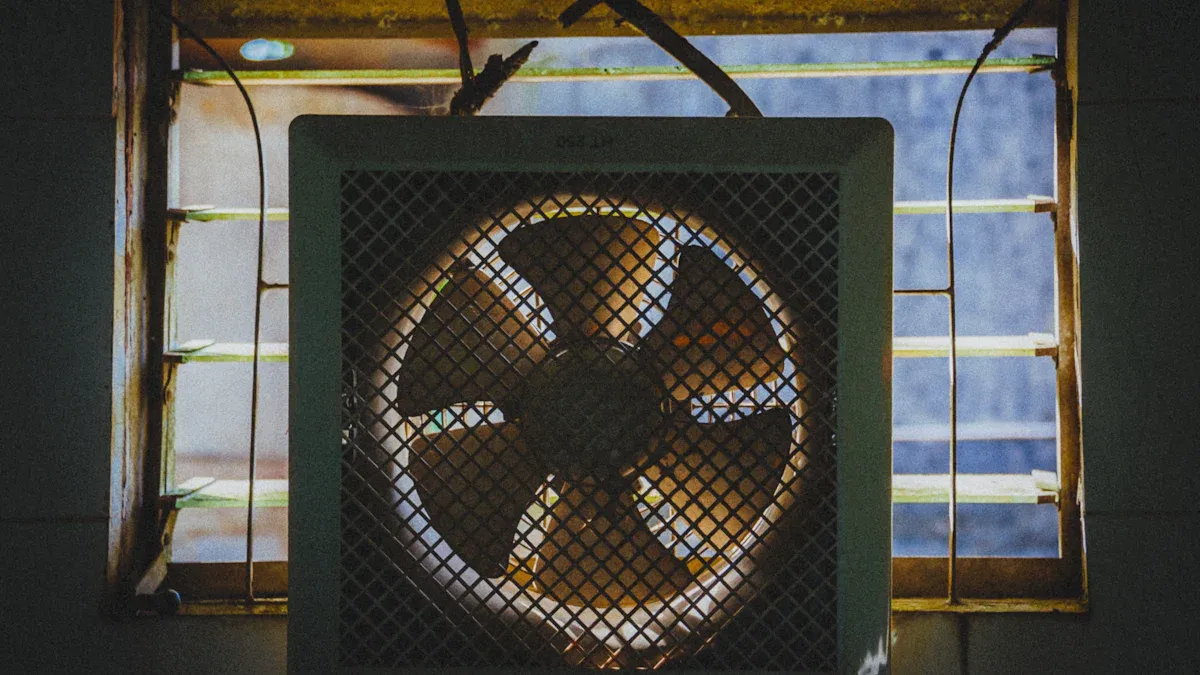
Dust Entry
You might not notice it at first, but dust finds its way into almost every cabinet. If your setup sits near construction, in a workshop, or even in a busy office, dust can sneak in through tiny gaps, vents, or when you open the doors. Over time, it settles on every surface inside. Even if you keep the room clean, dust from shoes, paper, or HVAC systems can drift into your cabinet.
Dust can clog cooling fans and vents.
It settles on circuit boards and connectors.
It builds up faster in areas with lots of foot traffic or open windows.
Tip: If you see a thin layer of dust on your equipment, it’s a sign you need better protection.
Contamination Risks
Dust does more than just look messy. It can cause real problems for your electronics. Here’s what can happen:
Mechanical wear increases as dust grinds into moving parts.
Overheating becomes a risk when dust blocks airflow.
Electrical failures may occur if dust bridges connections or degrades signals.
Network disruptions can happen when dust settles on connectors.
Studies show that dust buildup leads to overheating, system crashes, and even hardware damage. About 65% of IT equipment failures link back to poor cooling and contamination. Regular cleaning helps, but it’s not always enough. Advanced solutions like protective covers and environmental controls can help, but you need a way to keep dust out in the first place.
Fan with Filter
A Cabinet Fan with a filter gives you a strong defense against dust. The fan keeps air moving, while the filter traps dust before it can settle inside. Research on air cleaners and fan filters shows they can cut dust and particle levels by 30% to 80%, depending on the setup. HEPA filters, for example, remove up to 80% of fungal spores and pollen in homes. This means your cabinet stays cleaner, and your equipment runs better.
Fan filters work best when you check and replace them regularly.
Choose a filter that matches your cabinet’s airflow needs.
Some advanced fans come with self-cleaning features or dust sensors.
If you want to protect your electronics and avoid costly repairs, consider adding a Cabinet Fan with a filter. You’ll keep dust out and your equipment safe.
5. Hot Locations
High Ambient Temp
You might set up your equipment in a place that gets really hot. Maybe your cabinet sits in a garage, a warehouse, or near a window that gets direct sunlight. Sometimes, even indoor spaces heat up fast if there are lots of machines running or poor air conditioning. To know if you have a problem, check the highest temperature ever recorded at your location. Local climate data helps you spot trouble for outdoor setups. For indoor cabinets, measure the air temperature near your gear. This record tells you if your equipment faces extreme heat and helps you pick the right cooling solution.
Always check the maximum temperature at your installation site.
Use local weather data for outdoor cabinets.
Measure air temperature inside for indoor setups.
Make sure your cooling system can handle the hottest days.
Cooling Limits
Natural cooling methods, like opening a door or relying on vents, often fall short in hot places. Studies show that when temperatures and humidity rise, natural cooling just can’t keep up. Older adults and sensitive groups face even more risk, but anyone can run into problems. Even with windows open or fans running, indoor temperatures can stay high. Research shows that natural ventilation works best in mild climates. In hot spots, you need extra help. Many people can’t afford air conditioning or find it unsustainable, so you need a better way to keep things cool.
Fan Placement
You can boost your cooling by placing fans in the right spots. Studies show that optimizing airflow—like adjusting fan speed or the angle of air jets—can cut energy use by up to 17%. If you control where air enters and exits, you stop hot air from getting trapped. In open cabinets, most heat sneaks in from outside, so blocking infiltration can reduce cooling needs by 68% and lower compressor power by 87%. Multi-flow air curtains and smart fan setups keep temperatures steady and save energy. Try these tips:
Place fans near heat sources or at the top of the cabinet.
Use fans with adjustable speeds for better control.
Block gaps where hot air can sneak in.
Check airflow regularly and adjust as needed.
Tip: Smart fan placement not only keeps your equipment safe but also saves you money on energy bills.
You’ve seen five real-world reasons to check your cabinet’s cooling. Want to know if your setup needs better airflow? Try this quick checklist:
Does your cabinet hold high-heat or sensitive electronics?
Is airflow blocked or limited?
Do you spot dust or feel hot air inside?
Is your cabinet in a hot or dusty spot?
Are there signs of uneven temperatures or hot spots?
If you answered yes to any, it’s time to rethink your cooling. Studies show that using the right airflow method and layout keeps temperatures steady, prevents hot spots, and helps your equipment last longer. Good cooling also means you can save energy and avoid costly downtime.
FAQ
What size cabinet fan do I need?
You should match the fan size to your cabinet’s volume and heat load. Most manufacturers provide airflow ratings in CFM. Check your equipment’s cooling needs, then pick a fan that meets or exceeds that airflow.
How often should I clean or replace fan filters?
You should check filters every month. Dusty environments may need more frequent cleaning or replacement. A clogged filter blocks airflow and reduces cooling, so keep it clean for best results.
Can I install a cabinet fan myself?
Yes, you can install most cabinet fans with basic tools. Many models come with clear instructions. If you feel unsure, ask a professional for help.
Will a cabinet fan make a lot of noise?
Most cabinet fans run quietly, especially those designed for home or office use. Look for fans with low decibel ratings if noise concerns you. Some models even have silent or variable speed options.
Do cabinet fans use a lot of electricity?
No, cabinet fans use very little power. Most models run on less than 20 watts. You can run them all day without seeing a big jump in your energy bill.
See Also
Essential Tips For Protecting Outdoor Communication Cabinets
Choosing The Ideal Outdoor Electrical Cabinet For You
Top Five Benefits Of Using Outdoor Communication Cabinets
The Importance Of Cooling Systems In Outdoor Cabinets
Comprehensive Guide To Commercial Outdoor Communication Cabinets
CALL US DIRECTLY
86-13752765943
3A-8, SHUIWAN 1979 SQUARE (PHASE II), NO.111, TAIZI ROAD,SHUIWAN COMMUNITY, ZHAOSHANG STREET, NANSHAN DISTRICT, SHENZHEN, GUANGDONG, CHINA

